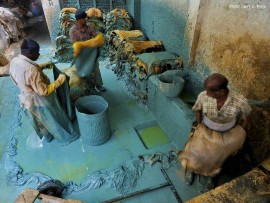Dye Industry
Dyes are primarily used in the production of consumer products and are commonly found in paints, textiles, printing inks, paper, and plastics - adding to the color and patterns of materials. Natural dyes have increasingly been replaced by chemical dyes that provide and retain richer color throughout wash and exposure1.
There are a vast number of chemical dyes, each with its own individual process. In the textile industry alone, there are more than 3,600 types of dyes. In acid dyes, the dyes are used to color animal fibers, while basic (alkaline) dyes are used for paper products. Direct dyes are used on cotton-wool or cotton-silk, and pigment dyes are used in paint and inks2. Many of these specific dyes have their own production process, but sulfuric acid, chromium, copper and other metals are commonly found throughout the entire dye industry, where dyes are mixed, synthesized, filtered, dried and blended. Along the way, many other additives, solvents and chemicals are added as a catalyst for reactions3. The number and variety of chemicals used corresponds with the intricacy of the desired patterns and designs in the clothing and textile industry. As a result, the wastewater effluents of dye factories can pose a complex threat to the health and environment of the surrounding population.
The textile industry is one of the largest sectors globally and produces 60 billion kg of fabric annually. The wastewater load from the use of dyes is a key component of pollution and puts approximately 1 million people at risk. Pure Earth has identified more than 50 sites where dye use poses a serious issue to health, although specifics of the risks remain to be clarified. The dye industry is currently the lowest contributor to DALYs on the top ten list, contributing an estimated 220,000 to 430,000 DALYs to the total burden of disease in the sites assessed. These DALYs are all a result of the health impacts from chromium and lead.
Key Pollutants
The top pollutants by population at risk reported in Pure Earth’s database are chromium, lead and mercury. Other harmful pollutants include cadmium sulfur, nitrates, chlorine compounds, arsenic, nickel and cobalt.
Exposure Pathways
Wastewater is a key pathway for exposure. In many pollution sites wastewater from the dye industry is directly dumped into surface waters without treatment. Wastewater carries a host of different chemicals from the processing of dyes and the World Bank estimates that textile dyeing and treatment contribute 17 to 20 percent of total industrial water pollution. The majority of pollution exposure in the Pure Earth’s database comes from ingestion of contaminated water and ingestion of food, which has been irrigated with contaminated water.
2. "Dye Manufacturing". Pollution Prevent and Abatement Handbook. World Bank Group. 1998?
3. Ibid.




